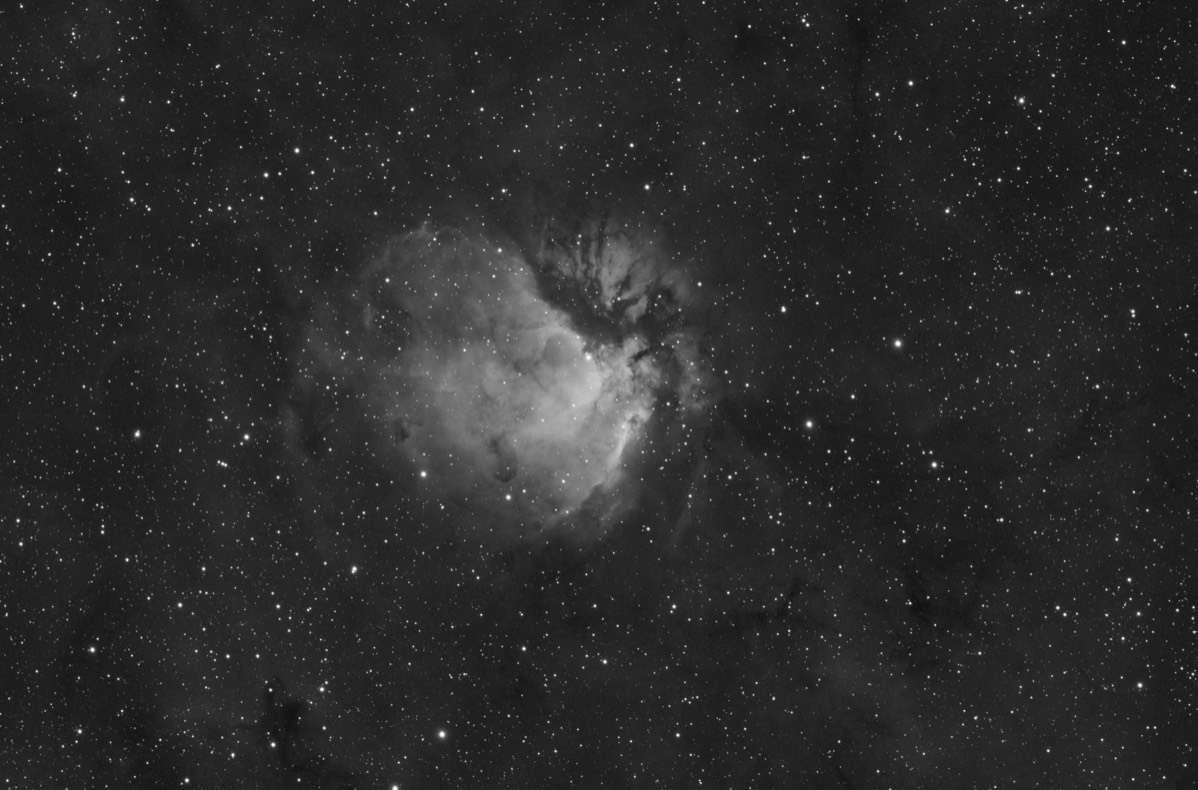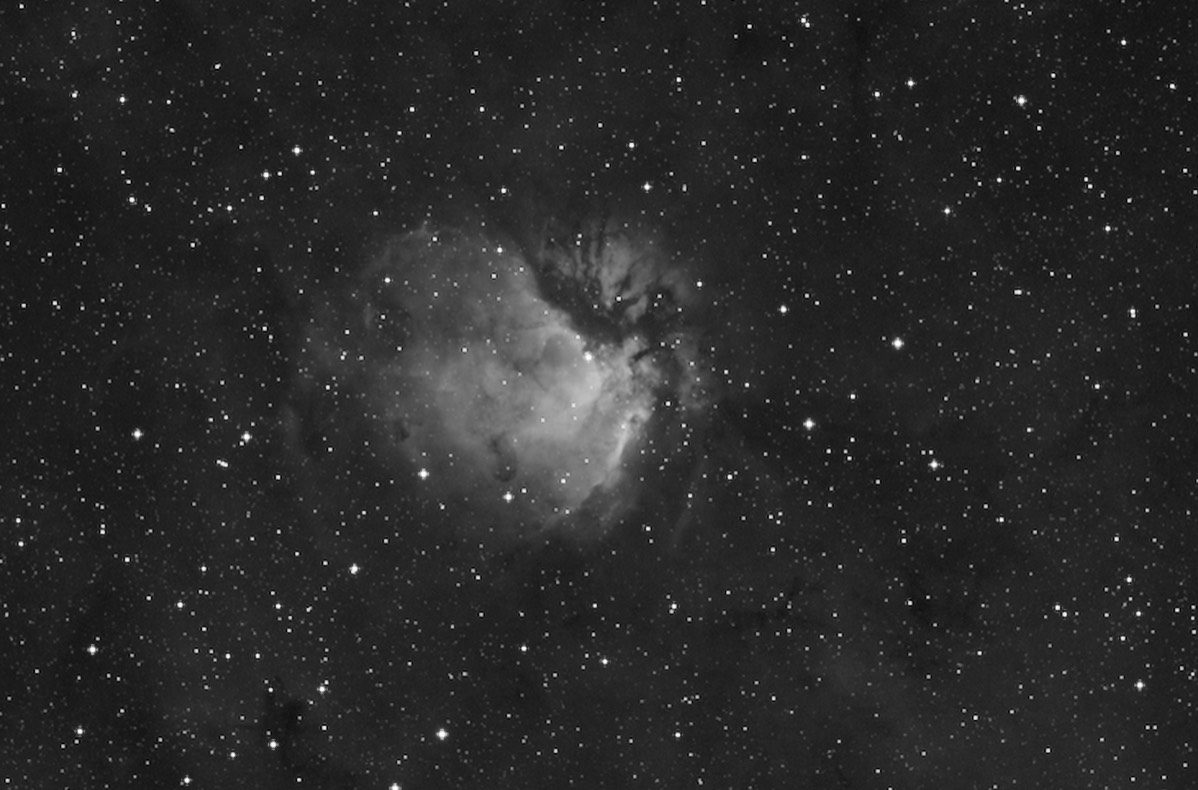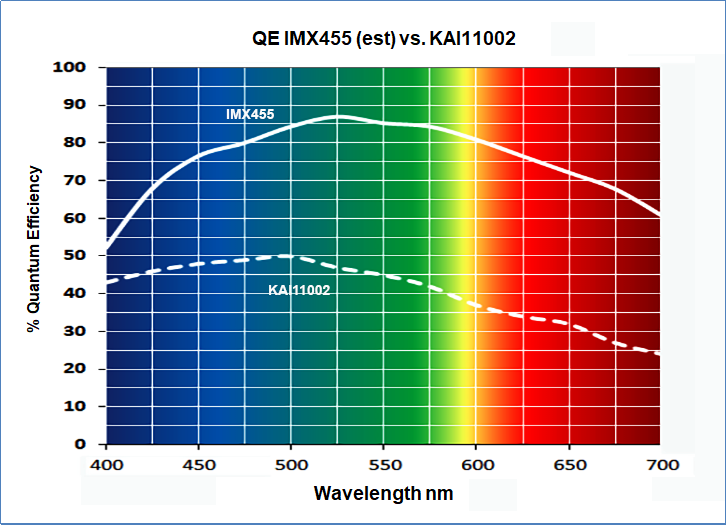ZWO ASI 6200 full frame CMOS Vs. SBIG STL 11K full frame CCD
Published 6 Aug 2020

ASI 6200 image: Full Resolution

STL 11K image: Full Resolution
Comparison between the ASI 6200 CMOS camera and STL 11K CCD camera. Is this the game changer?
Here is a quick comparison between the new (July 20) ZWO ASI 6200 full frame cooled astronomical CMOS camera and an older (2007) SBIG STL 11K full frame cooled astronomical CCD camera. This isn't a truly scientific study measuring every little detail about the two cameras but more of a comparison of the relative sensitivity of these two cameras using a moderate sized refractor. This comparison was done using a Stellarvue SVX152T 6" refractor mounted on a Paramount MyT telescope mount. This is also not an argument about which technology is better suited for astrophotography. There are many reviews available on-line detailing the differences in the two technologies. I have been hesitant over the last several years to upgrade my older CCD cameras since I've read a lot of reviews on CMOS cameras suffering from amp glow, non linearity and other problems. Unfortunately many of the main CCD manufacturers have quit making CCD's (A few very expensive ones are still being produced) but there will be enough in stock for several years so most of the major amateur astronomical camera vendors should still have new systems available for a while. On the other hand, CMOS technology is rapidly expanding and catching up to the performance of CCD's so is now the time to jump? I read several good reviews of the Sony IMX455 chip in the new ASI6200 and QHY600 cameras so I thought, could this be the CMOS chip to finally even the score?
Camera specs. Below is a listing of a few of the common specs of the two cameras.
SBIG STL-11K
Chip: Kodak KAI 11002 front illuminated interline ccd
Chip size: 36x24mm 35mm format
Pixel Size: 9 microns bin 1x1, 18 microns bin 2x2
Read Noise: 12-24 electrons depending upon Bin. Bin 2x2 was measured @24 e
Dark current: (measured @-5C) .028e/sec/pixel
QE: peak around ~50%, 40% blue, 28% Ha
16 bit
ZWO ASI 6200
Chip: Sony IMX455 back illuminated CMOS
Chip Size: 36x24mm, 35mm format
Pixel Size: 3.75 microns bin 1x1, 7.5 microns bin 2x2
Read Noise: 1.6-7.3e. Depends on Gain and Bin setting. In this case read noise at Gain 100 Offset 50 Bin 2x2 was measured @3.2 e
Dark Current: (measured @-5C) .009 e/sec/pixel
QE: peak around 85%, 73% Blue, 70% Ha
16 bit
The object I used in this comparison is an emission nebula called Sharpless 2-112 located in the constellation Cygnus. I shot this from 6-12 September of 2019 with the STL 11K camera so though it would be a good target to also use to gather a first light image with the new ASI 6200 camera on 1-6 Aug 2020. Both images where shot using the same telescope but there are a few differences. The image from the STL 11K camera was taken at f6 or 898 mm focal length. The image from the ASI 6200 camera was taken at f8 or 1216mm focal length. Both images are a stack of (27) 1200sec exposures using 2x2 binning. The image scale of the STL 11K image was 4.06 arcsec/pixel. The ASI 6200 was 1.28 arcsec/pixel. So, the STL was well under sampled but the large 18 micron pixels would gather a lot of light. The ASI 6200 was just a tad under sampled and the smaller pixels should gather less light, right? Both images were acquired using the same 50mm 5nm Astrodon Ha filter. Both images were taken under bright moonlight.
A quick note about the processing of these two images above. Both sets of images were calibrated using the Weighted Batch preprocessing script in PixInsight. For the STL images I used a master bias and master dark along with Flat frames. Dark frame optimization was used to scale the master dark to the short flat field images. For the ASI 6200, I took only dark frames for the light images and matching dark frames for the flat frames. The flats were calibrated with the flat darks. The light frames were calibrated with a master dark matching the light frames. Dark frame optimization was not used calibrating the ASI6200 lights. The master lights were both stretched using the auto screen transfer function in PixInsight and saved to a jpeg. No further processing was done.
A look at both images above shows very similar results. The nebula is nearly the same brightness in both. However the stars suffer in the STL 11K image since they were significantly under sampled and show artifacts due to the registration of both images. I think the ASI 6200 image has slightly more faint nebulosity visible and this faint stuff is a bit brighter. What do you think? The read noise in the ASI6200 raw images are also about half that of the STL11K images so that probably adds to equation. There are definitely more well resolved tiny stars in the ASI6200 image, probably a result of the much better sampling. Details are also better in the ASI 6200 image, again probably due to better sampling. So one might say both cameras worked just as well, right? Not so fast.
I would have expected the STL image to be brighter will more faint details due to it being shot with much larger pixels and faster optics which gather light more quickly. But thats not the case. The ASI image shot at f8 is just as bright if not better in the faint regions than the STL image shot at f6. Why is that?
As can be seen below, the Quantum Efficiency (sensitivity to light) of the IMX455 chip in the ASI 6200 camera is much, much better than the KAI 1100 chip in the STL11K. So even with slower optics and smaller pixels the ASI 6200 seems to have gathered just as much light as the STL 11K
Here is a quick comparison between the new (July 20) ZWO ASI 6200 full frame cooled astronomical CMOS camera and an older (2007) SBIG STL 11K full frame cooled astronomical CCD camera. This isn't a truly scientific study measuring every little detail about the two cameras but more of a comparison of the relative sensitivity of these two cameras using a moderate sized refractor. This comparison was done using a Stellarvue SVX152T 6" refractor mounted on a Paramount MyT telescope mount. This is also not an argument about which technology is better suited for astrophotography. There are many reviews available on-line detailing the differences in the two technologies. I have been hesitant over the last several years to upgrade my older CCD cameras since I've read a lot of reviews on CMOS cameras suffering from amp glow, non linearity and other problems. Unfortunately many of the main CCD manufacturers have quit making CCD's (A few very expensive ones are still being produced) but there will be enough in stock for several years so most of the major amateur astronomical camera vendors should still have new systems available for a while. On the other hand, CMOS technology is rapidly expanding and catching up to the performance of CCD's so is now the time to jump? I read several good reviews of the Sony IMX455 chip in the new ASI6200 and QHY600 cameras so I thought, could this be the CMOS chip to finally even the score?
Camera specs. Below is a listing of a few of the common specs of the two cameras.
SBIG STL-11K
Chip: Kodak KAI 11002 front illuminated interline ccd
Chip size: 36x24mm 35mm format
Pixel Size: 9 microns bin 1x1, 18 microns bin 2x2
Read Noise: 12-24 electrons depending upon Bin. Bin 2x2 was measured @24 e
Dark current: (measured @-5C) .028e/sec/pixel
QE: peak around ~50%, 40% blue, 28% Ha
16 bit
ZWO ASI 6200
Chip: Sony IMX455 back illuminated CMOS
Chip Size: 36x24mm, 35mm format
Pixel Size: 3.75 microns bin 1x1, 7.5 microns bin 2x2
Read Noise: 1.6-7.3e. Depends on Gain and Bin setting. In this case read noise at Gain 100 Offset 50 Bin 2x2 was measured @3.2 e
Dark Current: (measured @-5C) .009 e/sec/pixel
QE: peak around 85%, 73% Blue, 70% Ha
16 bit
The object I used in this comparison is an emission nebula called Sharpless 2-112 located in the constellation Cygnus. I shot this from 6-12 September of 2019 with the STL 11K camera so though it would be a good target to also use to gather a first light image with the new ASI 6200 camera on 1-6 Aug 2020. Both images where shot using the same telescope but there are a few differences. The image from the STL 11K camera was taken at f6 or 898 mm focal length. The image from the ASI 6200 camera was taken at f8 or 1216mm focal length. Both images are a stack of (27) 1200sec exposures using 2x2 binning. The image scale of the STL 11K image was 4.06 arcsec/pixel. The ASI 6200 was 1.28 arcsec/pixel. So, the STL was well under sampled but the large 18 micron pixels would gather a lot of light. The ASI 6200 was just a tad under sampled and the smaller pixels should gather less light, right? Both images were acquired using the same 50mm 5nm Astrodon Ha filter. Both images were taken under bright moonlight.
A quick note about the processing of these two images above. Both sets of images were calibrated using the Weighted Batch preprocessing script in PixInsight. For the STL images I used a master bias and master dark along with Flat frames. Dark frame optimization was used to scale the master dark to the short flat field images. For the ASI 6200, I took only dark frames for the light images and matching dark frames for the flat frames. The flats were calibrated with the flat darks. The light frames were calibrated with a master dark matching the light frames. Dark frame optimization was not used calibrating the ASI6200 lights. The master lights were both stretched using the auto screen transfer function in PixInsight and saved to a jpeg. No further processing was done.
A look at both images above shows very similar results. The nebula is nearly the same brightness in both. However the stars suffer in the STL 11K image since they were significantly under sampled and show artifacts due to the registration of both images. I think the ASI 6200 image has slightly more faint nebulosity visible and this faint stuff is a bit brighter. What do you think? The read noise in the ASI6200 raw images are also about half that of the STL11K images so that probably adds to equation. There are definitely more well resolved tiny stars in the ASI6200 image, probably a result of the much better sampling. Details are also better in the ASI 6200 image, again probably due to better sampling. So one might say both cameras worked just as well, right? Not so fast.
I would have expected the STL image to be brighter will more faint details due to it being shot with much larger pixels and faster optics which gather light more quickly. But thats not the case. The ASI image shot at f8 is just as bright if not better in the faint regions than the STL image shot at f6. Why is that?
As can be seen below, the Quantum Efficiency (sensitivity to light) of the IMX455 chip in the ASI 6200 camera is much, much better than the KAI 1100 chip in the STL11K. So even with slower optics and smaller pixels the ASI 6200 seems to have gathered just as much light as the STL 11K

QE comparison graphic from QHY
So as we can see above, even with slower optics and smaller pixels the ASI 6200 image is just as good, if not better, than the STL 11K image.
Many of the reviews I've read of CMOS chips in astronomical cameras mention two things that cause issues during calibration. First is amp glow. Amp glow shows up on the side of an image as a brighter area and is caused by the circuitry of the chip. It can be hard to calibrate out. Many earlier CMOS cameras suffered from some sort of Amp Glow. What about the ASI 6200? I can detect no Amp Glow in bias or dark frames, zero…Below are examples of master bias frames from both the ASI 6200 and STL 11K cameras.
Many of the reviews I've read of CMOS chips in astronomical cameras mention two things that cause issues during calibration. First is amp glow. Amp glow shows up on the side of an image as a brighter area and is caused by the circuitry of the chip. It can be hard to calibrate out. Many earlier CMOS cameras suffered from some sort of Amp Glow. What about the ASI 6200? I can detect no Amp Glow in bias or dark frames, zero…Below are examples of master bias frames from both the ASI 6200 and STL 11K cameras.

ASI6200 master bias bin 2x2 -5C stack of 60 raw bias frames

STL 11K master bias bin 2x2 -5C, stack of 30 raw bias frames
What I do see in the ASI 6200 bias frame is a vertical line that goes down the center of the image sort of splitting the image into two pieces. It's slightly brighter on the left. I can also see some very faint horizontal bands but both these features are at a very low level and they are not visible in any of the calibrated images. The STL bias frame shows several brighter columns and it gets generally brighter as you go from top to bottom. These features also calibrate out and cant be seen in any of the calibrated images.
Lastly, many reviews of CMOS cameras mention that the linearity of some cameras is not very good which can be a problem when applying flat frames during calibration or if one is going to do astrometry with the camera. I measured the linearity of the ASI 6200 using my flat panel at a very low light level and increasing exposure time. I actually had to do this several times as I found my flat panel flickered and changed brightness while warming up. I found the linearity to be very good with the ASI 6200 using the IMX455 chip. I included a graph below.
Lastly, many reviews of CMOS cameras mention that the linearity of some cameras is not very good which can be a problem when applying flat frames during calibration or if one is going to do astrometry with the camera. I measured the linearity of the ASI 6200 using my flat panel at a very low light level and increasing exposure time. I actually had to do this several times as I found my flat panel flickered and changed brightness while warming up. I found the linearity to be very good with the ASI 6200 using the IMX455 chip. I included a graph below.

ASI 6200 linearity graph. Adu value vs increasing time
The camera seems very linear, at least up through 50K ADU.
So what are my conclusions. Well, it seems that the IMX455 chip in the ASI 6200 camera is a great performer. It has extremely high QE, very low read noise, no amp glow and is very linear through the typical range used for astronomical images. The small pixels are a good match for modest telescopes like relatively small aperture refractors. The large 35mm format gives a very large field of view. The camera's performance is on par, or even better than many CCD camera's still available. In fact, when imaging with this camera it seemed just like using a ccd camera in its performance and results.
If you're looking for a highly sensitive, full 35mm format great performing camera, consider the new cameras with the Sony IMX455 sensor. It seems cameras with this chip may be the game changers in the transition from CCD to CMOS.
So what are my conclusions. Well, it seems that the IMX455 chip in the ASI 6200 camera is a great performer. It has extremely high QE, very low read noise, no amp glow and is very linear through the typical range used for astronomical images. The small pixels are a good match for modest telescopes like relatively small aperture refractors. The large 35mm format gives a very large field of view. The camera's performance is on par, or even better than many CCD camera's still available. In fact, when imaging with this camera it seemed just like using a ccd camera in its performance and results.
If you're looking for a highly sensitive, full 35mm format great performing camera, consider the new cameras with the Sony IMX455 sensor. It seems cameras with this chip may be the game changers in the transition from CCD to CMOS.

